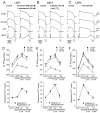Pharmacological approach to the treatment of long and short QT syndromes
- PMID: 18378319
- PMCID: PMC2386155
- DOI: 10.1016/j.pharmthera.2008.02.001
Pharmacological approach to the treatment of long and short QT syndromes
Abstract
Inherited channelopathies have received increasing attention in recent years. The past decade has witnessed impressive progress in our understanding of the molecular and cellular basis of arrhythmogenesis associated with inherited channelopathies. An imbalance in ionic forces induced by these channelopathies affects the duration of ventricular repolarization and amplifies the intrinsic electrical heterogeneity of the myocardium, creating an arrhythmogenic milieu. Today, many of the channelopathies have been linked to mutations in specific genes encoding either components of ion channels or membrane or regulatory proteins. Many of the channelopathies are genetically heterogeneous with a variable degree of expression of the disease. Defining the molecular basis of channelopathies can have a profound impact on patient management, particularly in cases in which genotype-specific pharmacotherapy is available. The long QT syndrome (LQTS) is one of the first identified and most studied channelopathies where abnormal prolongation of ventricular repolarization predisposes an individual to life threatening ventricular arrhythmia called Torsade de Pointes. On the other hand of the spectrum, molecular defects favoring premature repolarization lead to Short QT syndrome (SQTS), a recently described inherited channelopathy. Both of these channelopathies are associated with a high risk of sudden cardiac death due to malignant ventricular arrhythmia. Whereas pharmacological therapy is first line treatment for LQTS, defibrillators are considered as primary treatment for SQTS. This review provides a comprehensive review of the molecular genetics, clinical features, genotype-phenotype correlations and genotype-specific approach to pharmacotherapy of these two mirror-image channelopathies, SQTS and LQTS.
Figures


References
-
- Abbott GW, Sesti F, Splawski I, Buck ME, Lehmann MH, Timothy KW, et al. MiRP1 forms IKr potassium channels with HERG and is associated with cardiac arrhythmia. Cell. 1999;97:175–187. - PubMed
-
- Ackerman MJ, Khositseth A, Tester DJ, Hejlik JB, Shen WK, Porter CB. Epinephrine-induced QT interval prolongation: a gene-specific paradoxical response in congenital long QT syndrome. Mayo Clin Proc. 2002;77:413–421. - PubMed
-
- Ackerman MJ, Tester DJ, Porter CJ. Swimming, a gene-specific arrhythmogenic trigger for inherited long QT syndrome. Mayo Clin Proc. 1999;74:1088–1094. - PubMed
-
- Aiba T, Shimizu W, Inagaki M, Noda T, Miyoshi S, Ding WG, et al. Cellular and ionic mechanism for drug-induced long QT syndrome and effectiveness of verapamil. J Am Coll Cardiol. 2005;45:300–307. - PubMed
-
- Andersen ED, Krasilnikoff PA, Overvad H. Intermittent muscular weakness, extrasystoles, and multiple developmental anomalies. A new syndrome? Acta Paediatr Scand. 1971;60:559–564. - PubMed
Publication types
MeSH terms
Substances
Grants and funding
LinkOut - more resources
Full Text Sources
Other Literature Sources
Medical
Miscellaneous

